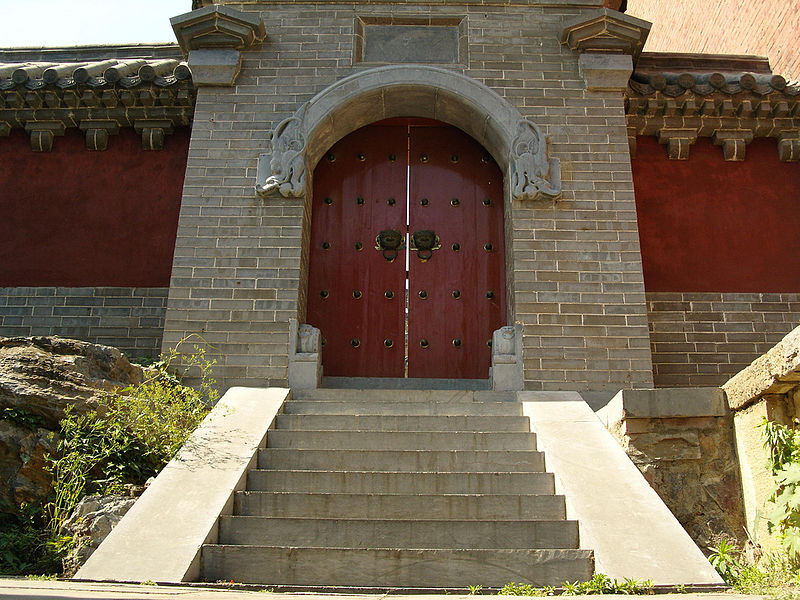





 |
 |
 |
 |
 |
 |
|---|---|---|---|---|---|
Using the sun as a fusion reactor and harnessing it with photocells will always have cheaper power/$ than Earth-based fusion. For fusion by tokamak or laser, the power/$ and energy/$ are too weak for profitability by orders of magntitude.
Earth-based fusion requires tritium, which can only be made in fission reactors. A fission produces 180 MeV plus a tritium, and fusing the tritium produces 22 MeV. Hardly worth it.
Tritium decays to helium-3, and helium-3 is needed for dilution refrigerators, which are needed for technologies like quantum computing. Most tritium should be given over to dilution refrigerators.
Earth-based fusion produces neutrons, which make the lab radioactive. The sun's radioactivity is shielded by the Earth's magnetic field and atmosphere.
Plasma tokamak fusion hinges on tokamak size and magnetic field strength. Field strength is nearly topped out, so the way forward is increasing tokamak size. ITER is far from large enough for profitable fusion.
 |
|---|
For electricity,
Power/$ Energy/$
Watt/$ MJoule/$
Generator 10 100 Gasoline, natural gas, or coal
Fission 2 1300
Photoelectric .6 400
Tokamak, ITER .022 14 International Thermonuclear Experimental Reactor
Laser, NIF .00000002 .000006 National Ignition Facility
Plasma fusion and laser fusion are barely able to reach ignition and profitability is far off.
Fusion power scales as radius cubed times magnetic field to the 4th power. Magnetic field is topped out, so the way forward is increasing size.
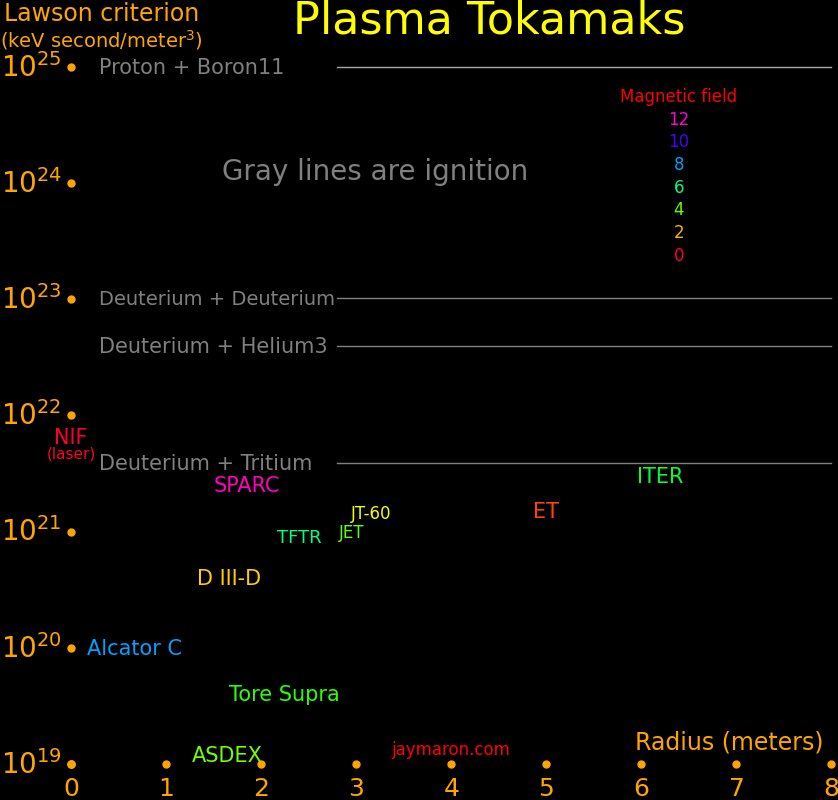 |
|---|
Helium-3 can be mined from the moon but it's unprofitable. It's more cheaply made in fission reactors. Fission reactors should be breeding tritium and helium-3.
The easiest fusion reaction is deuterium+tritium, and tritium comes from fission. Fission produces 180 MeV of energy and a tritium. Fusing the tritium with deuterium gives 18 MeV, much less than the fission.
Fission reactors are usually used for electricity and heat but they can do more, such as creating valuable elements by transmutation. They can transmute cheap tungsten into valuable rhenium, osmium, iridium, platinum, and gold. They can make medical isotopes and they can do neutron cancer therapy. They can make neutrons for scientific research. They can make nuclear batteries.
Burnt fission fuel has rhodium and palladium, which are valuable catalysts. The older the burnt fuel, the less radioactive it is, and the easier it is to extract these elements. Article on fission reactors.
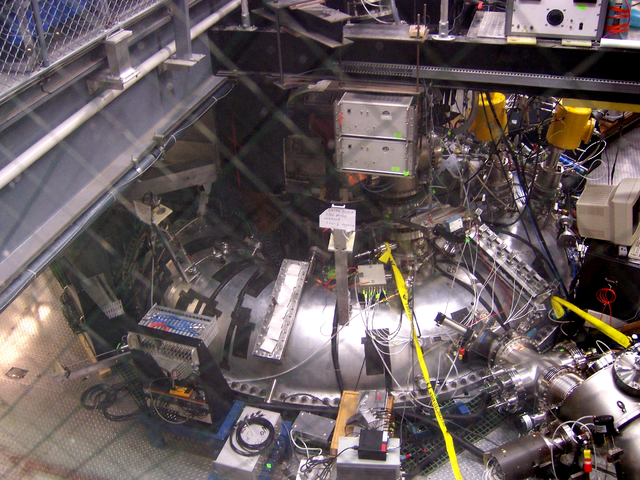 |
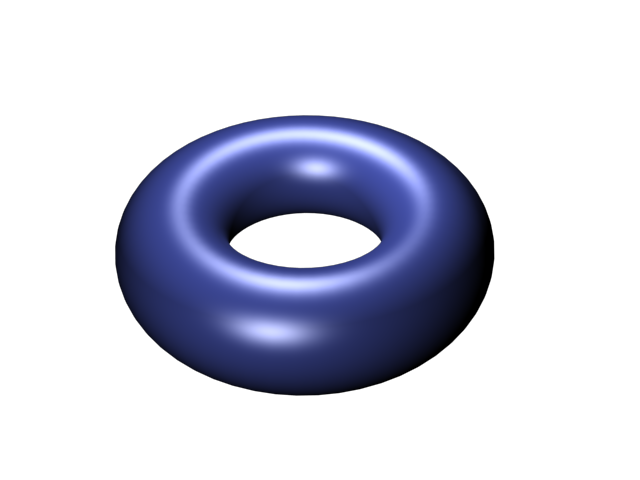 |
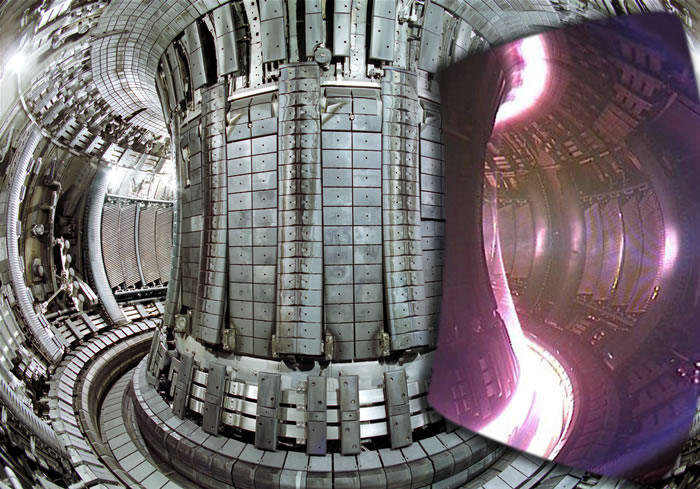 |
|---|---|---|
A tokamak confines a plasma by using magnetic fields to steer plasma particles around a torus. Virtue is size and magnetic field strength. The larger the values, the longer the plasma confinement time and the larger the plasma density.
 |
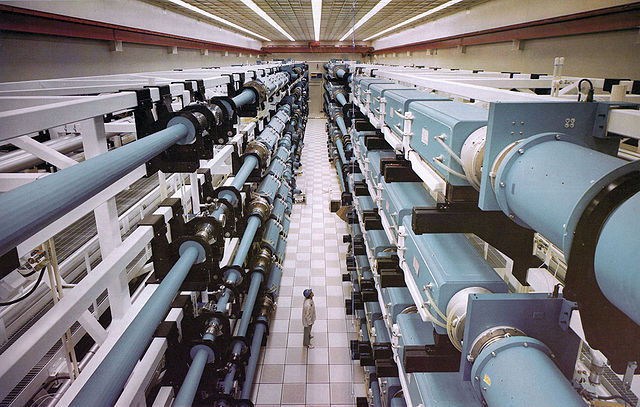 |
|
|---|---|---|
In laser fusion, lasers compress a sphere of fuel to a density and temperature high enough for fusion. The sphere consists of fusion fuel in the interior and an ablation layer in an outer shell. The laser ejects atoms from the ablation layer and the recoil compresses the fuel. The compression needs to be spherically symmetric and so a large number of lasers are used to evenly distribute the energy over the sphere. This technique is referred to as "inertial confinement".
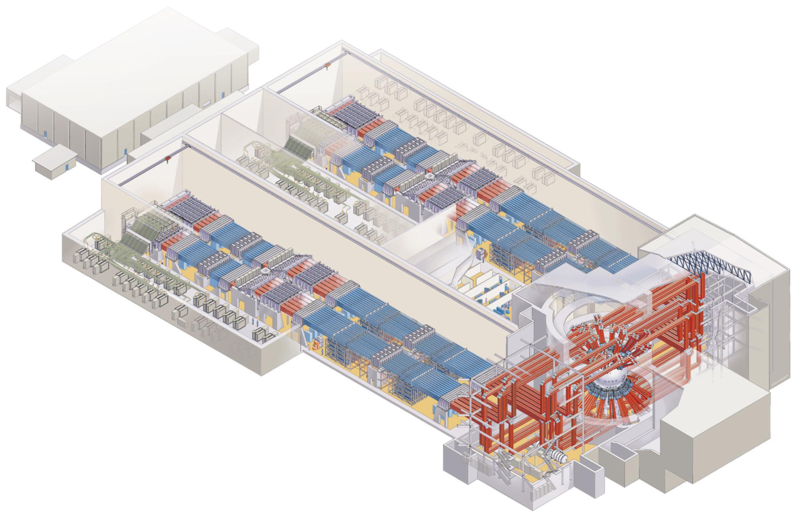 |
|---|
In the National Ignition Facility, 192 lasers (at left) are focused onto a target (at right). Fiber optics steer laser beams.
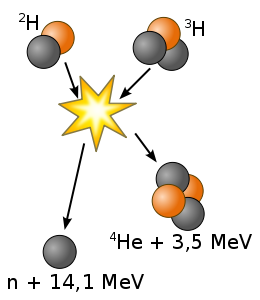 |
|
|---|---|
The easiest fusion reaction is
Deuterium + Tritium → Helium (3.5 MeV) + Neutron (14.1 MeV)
The optimal temperature is 26 keV and other fusion reactions need higher temperature.
Other fusion reactions include:
Temeperature Lawson Density*Time
keV e20 keV s/m3 e20 s/m3
Deuterium + Tritium 26 39 1.5
Deuterium + Helium 100 400 4
Deuterium + Deuterium 100 1020 10.2
Proton + Boron11 200 100000 500
"Temperature" is the optimum temperature for fusion.
"Lawson" is the Lawson criterion required for ignition.
"Density*Time" is the density times confinenment time needed for ignition at the optimal temperature.
To ignite fusion, the "Lawson criterion" must exceed a critical value. The Lawson criterion is the product of confinement time, plasma density, and temperature.
The biggest tokamaks barely reach ignition.
 |
|---|
Fusion power scales as radius cubed times magnetic field to the 4th power.
If a tokamak larger than ITER is built, the magnetic field will be similar to ITER's. Doubling the size of ITER increases fusion power by a factor of 8, still far short of profitability. Doubling size increases cost by a factor of 8. Superconducting magnets are a big part of the cost. Magnet technology is a major focus of ITER.
ITER barely reaches ignition, and profibability requires going beyond ignition by a factor of around 50. Profitability likely requires a tokamak at least 4 times the size of ITER.
Fusion has feeble power/$ and energy/$ compared to a natural gas plant. Tokamak power/$ is 1000 times worse than a natural gas plant, and laser fusion is worse than tokamaks. Commercial fusion is far off.
ITER has a radius is 6 meters and and costs 20 B$, and it's not nearly big enough for commercial fusion. Tokamak cost scales as radius cubed.
Power/$ Energy/$ Input Output Input Output Cost
power power energy energy
Watt/$ MJoule/$ MWatt MWatt MJoule MJoule B$
Tokamak, ITER .022 16 50 500 - - 20
Laser, NIF .00000002 .000006 .004 .00007 400 7 3.5
Generator, coal 10 128
Generator, natural gas 10 100
Generator, firewood 10 88
Generator, gasoline 10 20
Fission 2 1300
Hydroelectric 2 1300
Wind turbine 1 650
Photoelectric .6 400
The NIF laser gives one shot per day. The input and output energies are for one shot.
To calculate energy/$ for tokamaks, lasers, photoelectric, wind turbines, fission, and hydroelectric, we assumme that the plant runs for 20 years.
Helium-3 is needed for dilution refrigerators more than for fusion. A dilution refrigerator can reach 2 millikelvin and is vital for quantum computing. Fermilab is building the world's largest diffusion refrigerator, with a volume of 1.5 meter3.
Helium-3 is 1 M$/kg and tritium is 30 M$/kg. America has 30 kg of helium-3 and 30 kg of tritium.
Helium-3 is made from fission neutrons:
Lithium-6 + Neutron → Helium-4 + Tritium + 4.793 MeV Fission Tritium → Helium-3 + Electron + .0186 MeV Decay with a half life of 12.3 years Helium-3 + Deuterium → Helium-4 + Proton + 18.3 MeV Fusion
Producing a fission neutron comes with 180 MeV of thermal energy. The neutron can make tritium for a fusion reactor to produce even more energy, but fusing tritium gives only 17.6 MeV. It's not worth recycling the neutrons for more power. Use neutrons instead for transmutation.
The energy gained from fusing lunar regolith is not much larger than the energy needed to mine it, and this assumes ideal circumstances. It's unlikely to be profitable.
Regolith fusion energy/kg = 5.8 MJoule/kg Regolith mining heat per kg = 1.4 MJoule/kg Helium-3 in lunar regolith, best ore = 10 ppb Helium-3 energy/mass from fusion = 584 TJoule/kg = 18.3 MeV / 3.016 Daltons
Helium-3 is extracted by sorting out the finest regolith particles and heating them to 700 Celsius.
Regolith temperature change = 700 Kelvin Regolith heat capacity = 2000 Joule/kg/Kelvin Regolith mining heat per kg = 1.4 MJoule/kg
Producing 1 year of power for America needs 23000 km2 of lunar surface, which is .06% of the moon's surface. The good ore would be exhausted within a century.
America energy usage in 1 year = e20 Joules Helium-3 needed for 1 year of American power = 171000 kg Mass of regolith needed = 17 Bkg Regolith density = 1500 kg/meter3 Regolith useful depth = .5 meter Moon regolith area needed = 23 kkm2 Moon total surface area = 38000 kkm2
The largest tokamak is the International Thermonuclear Experimental Reactor (ITER) in France. It will be the first tokamak to produce more fusion power than is required to operate the machine. There are numerous international participants and the experiment is as important for its superconducting magnet technology as it is for fusion. For the ITER reactor,
Fusion power = 500 MWatt Input power = 50 MWatt Temperature = 500 MKelvin Confinement time = 3000 seconds Plasma current = 17 MAmps Magnetic field = 5.3 Tesla Inner radius = 2.0 meter Outer radius = 6.0 meter
The "Lithium Tokamak Experiment" at the Princeton Plasma Physics Laboratory uses flowing liquid lithium walls to absorb hydrogen that escapes the plasma. This improves plasma confinement and is potentially a means for absorbing the heat generated by fusion neutrons.
Outer Lawson Magnetic Confine
radius field time
meter e20 Tesla second
ITER 6.2 30 5.3 3000 France Future
SPARC 1.85 25 12.2 10 MIT Future
ET 5.0 15 1.0 USA
JET 2.96 10 4.0 UK
JT-60 3.16 10 2.7 100 Japan
TFTR 2.4 9 6 Princeton
D III-D 1.66 4 2.2 San Diego
Alcator C .67 1 8 MIT
Tore Supra 2.25 .4 4.5 390 France
KSTAR 1.8 3.5 300 Korea
FTU .93 8 1.5 Italy
ASDEX 1.65 .12 3.9 10 Germany
The National Ignition Facility uses one laser pulse and it found that this is not able to achieve break-even fusion energy. The HiPer experiment was subsequently built to test a two-pulse strategy. The first pulse compresses the fuel and a second pulse further heats it. The first pulse is spherically symmetric and the second pulse is a beam fired into the core of the compression zone.
Electric Laser Fusion Target
energy energy energy density
MJ MJ MJ g/cm3
National Ignition Facility 330 1.85 20 1000 1 laser pulse
HiPer 422 .27 25 300 2 laser pulses
Electric energy Energy supplied to the system
Laser energy Laser energy delivered to the target
Fusion energy Energy produced by fusion of the traget
Target density Density of the target after laser compression
Fusion reactions:
Energy Coulomb Aneutronic
yield energy
MeV
P + N → D + Gamma 2.22 0 *
P + P → D + Positron .42 1 * Slow because it needs the weak force
P + D → He3 + Gamma 5.49 1 * Slow because it needs the electromagnetic force
D + D → T + P 4.03 1 * 50%. Tritium = 1.01 MeV, Proton = 3.02 MeV
→ He3 + N 3.27 1 50%. He3 = .82 MeV, Neutron = 2.45 MeV
D + T → He3 + N 17.58 1 He3 = 3.52 MeV, Neutron = 14.06 MeV
T + T → He4 + 2N 11.3 1
He3 + N → T + P + Gamma .764 0 * 5330 barns
He3 + D → He4 + P 18.353 2 * D+D side reactions make neutrons
He3 + T → He4 + P + N 12.1 2 57%
→ He4 + D 14.3 2 * 43%
He3 + He3 → He4 + P + P 12.860 4 *
Li6 + N → He4 + T + Gamma 4.783 0 *
Li6 + P → He4 + He3 4.0 3 *
Li6 + D → He4 + He4 22.4 3 * D+D side reactions produce neutrons
→ He4 + He3 + N 2.56 3
→ Li7 + P 5.0 3 *
→ Be7 + N 3.4 3
Li6 + He3 → He4 + He4 + P 16.9 6 *
Li7 + N → He4 + T + N -2.467 0
Li7 + P → He4 + He4 17.2 3 *
B11 + P → He4 + He4 + He4 8.7 5 *
N15 + P → C12 + He4 5.0 7 *
C13 + He4 → O16 + N Stellar s-process
Ne22+ He4 → Mg25 + N Stellar s-process
The fusion of deuterium and tritium produces neutrons with an energy of 14.1 MeV. These neutrons dislodge atoms in materials, weaking the material.
In the following sequence of frames a 30 keV Xenon ion crashes into gold, disrupting the positions of atoms.
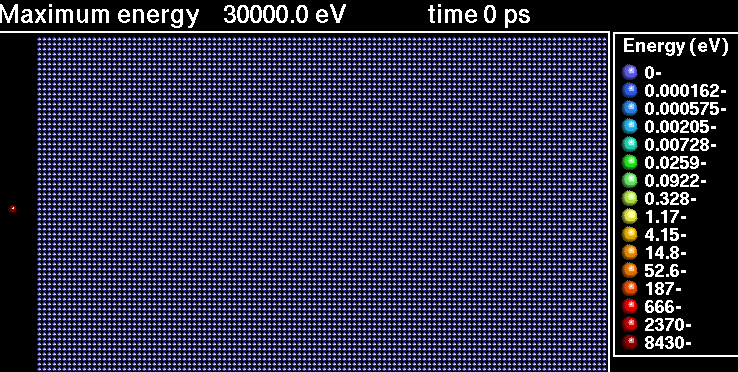 |
 |
|---|---|
 |
 |
|---|---|
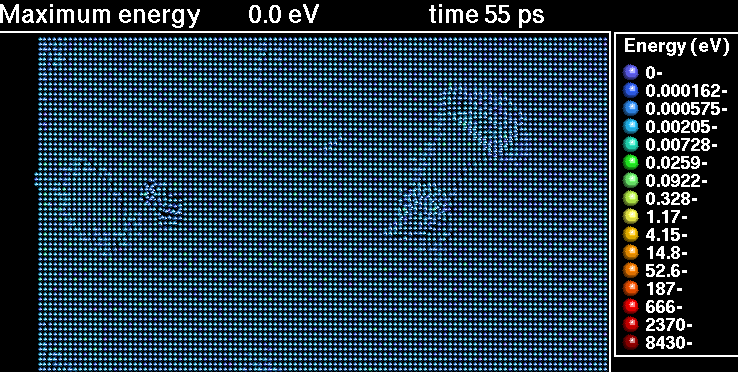 |
|
|---|---|
Liquid lithium wallls are being considered for stopping the neutrons. Lithium also absorbes hydrogen that escapes the plasma and improves the plasma confinement properties.
Lithium Tokamak Experiment
International Fusion Materials Irradiation Facility
 |
|---|